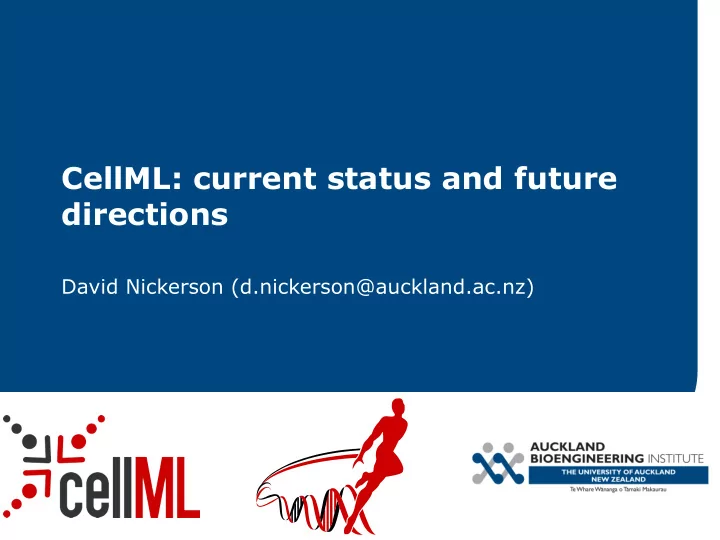

CellML: current status and future directions David Nickerson (d.nickerson@auckland.ac.nz)
What is CellML? The purpose of CellML is to store and exchange computer- based mathematical models . CellML allows scientists to share models even if they are using different modelling tools. It also enables them to reuse components from one model in another, thus accelerating model development. • MathML within a modular, reusable framework. • Unambiguous and tool-independent description of a set of mathematical equations. • Typically describing a system of differential algebraic equations. • Units, units, units... 3
Beyond CellML 1.1 • A broad specification of “fundamental CellML concepts” – MathML plus the core CellML elements and attributes • Secondary specifications narrow the scope of the fundamental concepts – Typically to enable computational simulation of a specific class of mathematical model(s). – For example: index-1 DAE models which do not invlove simultaneous equations and only use a restricted subset of MathML 2.0 elements.
CellML 1.2 • Released as the fundamental concepts specification plus a collection of secondary specifications. • Scope similar to what is currently supported by the CellML Integration Service with some notable additions: – Variable typing – Reset rules – Delays – Stochastic variation – Minor corrections and updates.
Variable typing • Fundamental concepts allows arbitrary types. – Type attribute added to variables, value is a URI which defines the type. • Secondary specification restricts this to real and boolean types only. • Interaction of types with units – Must be defined if type real, must be absent when type boolean. • Future relaxation to allow vectors, matrices, etc., without needing to change fundamental concepts specification.
Representing Parameter Uncertainty in CellML • Often, parameters will be determined experimentally. • Experimental error means that there is inherent uncertainty in experimentally determined parameters. • Some parameters vary between individuals in a population; even if the mean value for a population is known, the value for an individual might not be. • Sometimes, only a sensible range for parameter values is known; the exact value is unknown. In this case, a modeller might want to say a parameter is uncertain and equally likely to take any value in the range. • Proposal from Andrew Miller.
https://tracker.physiomeproject.org/show_bug.cgi?id=55
Electing a CellML Editorial Board • Recent call for nominees resulted in 10 nominees standing for election to the CellML Editorial Board. • Spanning the globe from New Zealand to the UK. • Soon to be a call for votes! • http://www.cellml.org/community/boardnominees • http://lists.cellml.org/mailman/listinfo/cellml-discussion
The Physiome Model Repository • http://models.physiomeproject.org • A repository for models as part of the Physiome, VPH, VPR projects and pretty much any one else. • CellML specific models available via: http://models.cellml.org • FieldML specific models available via: http://models.fieldml.org
PMR2 • Workspace – data agnostic mercurial repository • Changeset – a representation of a single revision of the content of a workspace • Exposure – a permanent link to a specific changeset with data rendered for the web • Exposure plug-ins – an extensible framework for rendering workspace content for web presentation • Plone CMS – workflow manager; user access controls; web presentation; etc.
Embedded Workspaces • Intended to manage the separation of modules which are integrated to create a model • Facilitate the sharing and reuse of model components independently from the source model • Enables the development of the modules to proceed independently, thus the version of the workspaces embedded is also tracked • Allows authors to make use of relative URIs when linking data resources providing a file system agnostic method to describe complex module relationships in a portable manner
Embedded Workspaces • Workspaces can be embedded at a specific revision or set to track the most recent revision of the source workspace • Changes made to the source workspace will not affect the embedding workspace until the author explicitly chooses to update the embedded workspace • Provides the author with the opportunity to review the changesets and make an informed decision regarding alterations to embedded revisions
FieldML: a meta-language for field interchange • A standard format for interchanging field descriptions and data between different software. • Able to describe fields of arbitrary complexity. • Efficient. • Extensible. • Reusable model components. • http://precedings.nature.com/documents/5901/version/1
Acknowledgements • Poul Nielsen • Alan Garny • • Peter Hunter Mike Cooling • Tommy Yu • The CellML community • Andrew Miller • Auckland Bioengineering Institute • Randall Britten
Recommend
More recommend